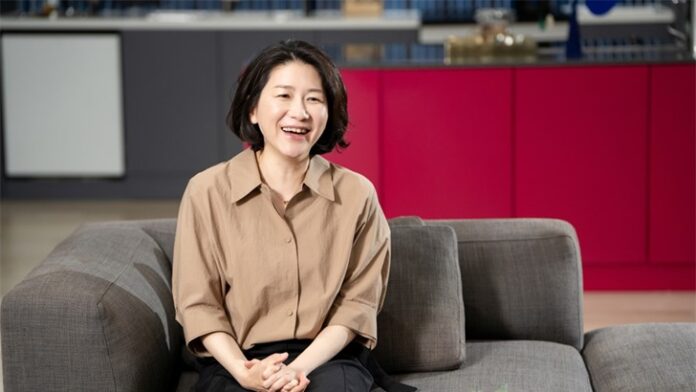Guided by its vision of “AI for All,” Samsung Electronics continues to develop home appliances that are intuitive and convenient for a wide range of home environments. Among the most impactful advancements are accessibility features designed to make these appliances easier to use for individuals with disabilities and older adults — reflecting the company’s commitment to inclusive design.
Samsung Newsroom sat down with Bona Lee, Vice President and Head of Customer eXperience (CX) Insight Group at Digital Appliances (DA) Business, Samsung Electronics, to discuss the latest accessibility features in Samsung’s home appliances and the philosophy that shapes them.
▲ Bona Lee from Samsung Electronics demonstrates the negative color mode on the Family Hub refrigerator’s display.
Q. What core value or principle guides your approach when designing accessibility features for home appliances?
Using home appliances typically involves a combination of sensory input — such as sight, sound and touch — along with cognitive functions like making selections and adjusting settings, as well as physical actions like pulling, pushing or lifting. These steps can present challenges for some users.
Samsung is working to reduce or eliminate these usability barriers to ensure that everyone can access all features and benefit from the latest technologies. As part of our broader commitment to inclusive design, we offer tailored solutions for different accessibility needs — such as tactile stickers for buttons, audio cues for users with visual impairments and control panels positioned at heights accessible to wheelchair users.
Q. What are some standout accessibility features or services that users might not be aware of?

▲ Visibility enhancement settings on the Bespoke AI Laundry Combo
The Bespoke AI Laundry Combo offers a significantly more streamlined control experience than before. While previous models required users to turn a dial and strain to read small text to select a cycle, the new model features a built-in digital screen with large, easy-to-read fonts. AI further enhances usability by prioritizing frequently used cycles at the top of the menu.
What’s more, SmartThings routines empower individuals with limited mobility by automating device control. A simple voice command like “I’m going to sleep” can turn off lights and appliances, creating a more comfortable and accessible home environment.
Q. What new accessibility features have been introduced in the 2025 Bespoke AI appliance lineup?
In the 2025 lineup of Bespoke AI appliances, Bixby can now recognize individual voices using Voice ID technology and provide accessibility settings tailored to each person. In addition, with built-in microphones and speakers, users can ask Bixby about the appliance’s status and receive key alerts via voice responses.
Moreover, the Auto Open Door feature — highly praised by users with limited mobility — has been expanded to more products, including refrigerators, washing machines, ovens and dishwashers. A light tap or simple voice command like “Open the [device] door” provides easy, hands-free access.

▲ The Auto Open Door feature on the Family Hub refrigerator
Q. Are there any ongoing collaborations focused on enhancing accessibility in home appliances?
Samsung is actively collaborating with various organizations to identify and address real-world accessibility challenges. We receive objective evaluations and expert guidance from various professional organizations including the Korea Center for Accessibility Assessment & Research. Additionally, accessibility features for our screen-equipped appliances — such as voice guidance and improved visibility — are being developed in alignment with the European Accessibility Act that goes into effect this June.
Internal collaboration is just as vital. The Samsung Family Supporters group — comprised of employees with disabilities and those with family members who have disabilities — is actively involved in shaping accessibility initiatives. Furthermore, the newly established Accessibility Employee Resource Group (ERG) within the Device eXperience (DX) Business fosters open dialogue by encouraging members to share real-life experiences and ideas to improve accessibility across our products and services.
Q. What results or improvements have come from these collaborations so far?
While many visually impaired users found voice guidance for operating SmartThings-connected appliances helpful, some reported that the initial device connection process was challenging.
To address this, we improved the SmartThings app and partnered with TUAT Corp. — the developer of AI-powered visual assistance app Sullivan Plus — to introduce a dedicated mode that recognizes Samsung appliances and helps users easily connect them to SmartThings. Selected for Samsung’s C-Lab Outside startup incubator, Sullivan Plus is expected to further enhance the overall user experience.
We’ve also developed assistive tools based on ideas and feedback from employees and the Samsung Family Supporters group. Designs for these tools are shared on ITDA, a public platform for customizing and 3D-printing assistive devices. One example is a stick-on handle for drawers, designed to support users with limited hand mobility. Development continues toward creating more automated assistive solutions that offer even greater convenience.
Q. What steps is Samsung taking to further advance its vision of “AI for All” in the future?
“AI for All” reflects Samsung’s commitment to ensuring that the benefits of technology are seamlessly integrated into everyday life — regardless of a user’s physical abilities or environment. It’s about transforming individual features into connected, inclusive experiences that make life better for everyone.
Looking ahead, Samsung will continue to embed universal design principles that prioritize inclusivity into product development. This includes gathering input from diverse user groups during the planning stage, leveraging user data to identify new opportunities and collaborating with both internal and external experts and organizations to create more meaningful solutions.
As AI capabilities in home appliances evolve, the goal is to create a truly intelligent in-home experience — one that understands each user, their family and their environment by automating tasks and reducing the need for manual input. Rather than addressing diversity with isolated features, Samsung strives to deliver integrated, all-in-one solutions that adapt to any situation.
We see this as the future of innovation — where accessibility and technology come together to serve everyone, under the vision of “Universal Accessibility, Universal Technology.”


